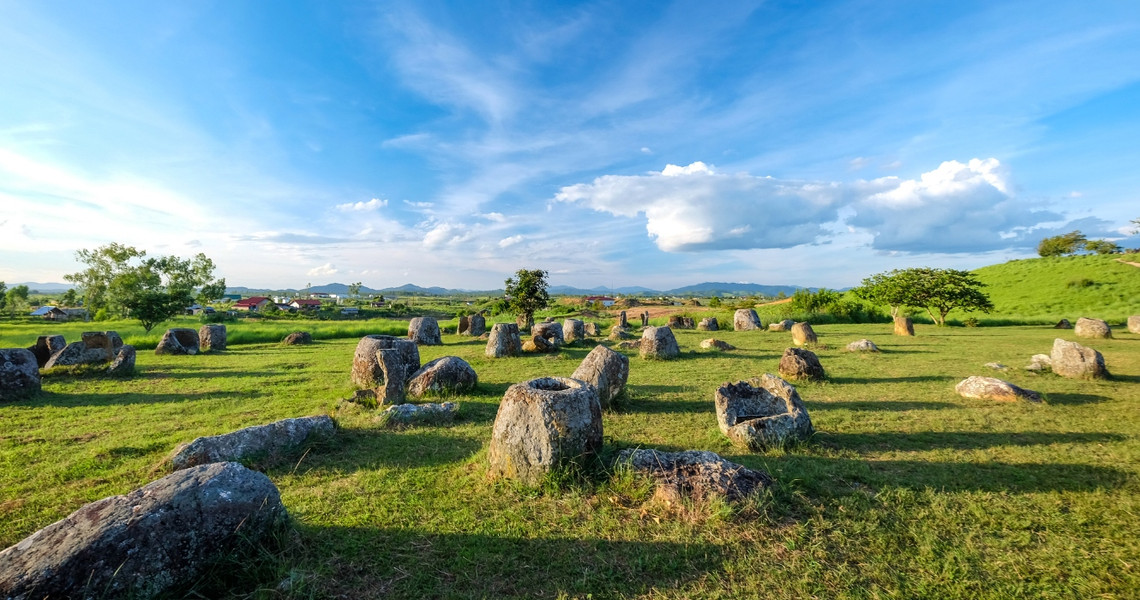Southeast Asia brims with iconic temples, turquoise waters, and bustling markets—yet for travellers craving a deeper, more enigmatic adventure, the Plain of Jars in Laos stands apart.
Scattered across the misty highlands of Xieng Khouang province, thousands of ancient stone jars whisper secrets of a forgotten civilisation. Who crafted these megaliths?
Were they burial urns, rice wine vats, or something more mystical? For first-time visitors, this UNESCO-listed site offers a rare blend of history, intrigue, and off-the-beaten-path exploration.
The Enigma of the Plain of Jars

Dating back to Laos’ Iron Age (500 BCE–500 CE), the Plain of Jars is an archaeological marvel. Over 2,100 sandstone jars, some towering three metres high, dot the landscape like relics from a giant’s banquet. Local legends speak of a race of giants who used them to brew celebratory rice wine, while archaeologists propose they served as funerary vessels holding bones or bodies before cremation.
Ongoing research hints the jars may be even older than thought, adding layers to the mystery. Unlike Angkor Wat or Borobudur, this site feels undiscovered, offering a hauntingly quiet communion with the past.
Why Visit?

1. Step Into a Real-Life Archaeological Puzzle
Unlike textbook-perfect ruins, the Plain of Jars refuses to surrender its secrets. With no inscriptions or clear records, the jars are a blank canvas for imagination. Were they part of an ancient burial ritual? Storage for fermenting rice wine, as local legends claim? Or something even stranger? Walking among them feels like joining an Indiana Jones expedition minus the crowds.
2. A UNESCO Site That Feels Undiscovered
While tourists queue for hours at Angkor Wat, you'll have the jars nearly to yourself. Only three main sites (1, 2, and 3) are easily accessible, with others (like Site 52) requiring adventurous detours. The solitude amplifies the magic: imagine golden light filtering through mist as you ponder millennia-old craftsmanship.
3. A Lesson in Resilience and Remembrance
The jars survived the bombs. Between 1964 and 1973, the U.S. dropped over 2 million tons of ordnance on Laos the most heavily bombed country per capita in history. Today, MAG (Mines Advisory Group) teams still clear unexploded devices. Visiting the UXO Visitor Centre in Phonsavan adds depth to your trip, turning stones into symbols of survival.
4. Connect With Laos' Living Culture
The jars aren't relics behind glass they're woven into local life. Nearby, the Hmong and Khmu villages share oral histories passed down for generations. Stay overnight in a community homestay, learn to cook khao soi (noodle soup), and hear tales of giants and spirits. Pro tip: Bring small gifts (school supplies, fabric) to thank hosts.
5. Adventure Without the Hassle
There are no visa hassles (30-day visa-on-arrival for most nationalities), budget-friendly costs, and landscapes straight from a fantasy novel. Plus, the journey there through Laos' emerald hills and past roadside pho stalls is half the fun.
Practical Guide: How to Explore Safely & Responsibly
Best Time to Visit
| Season | Months | Why It’s Ideal |
| Dry & Cool | Nov–Feb | Pleasant temps (15–25°C), clear paths |
| Shoulder | Mar–Apr | Warmer but dry; fewer visitors |
| Avoid the rainy season (May–Oct), when trails turn muddy and UXO risks rise. | ||
Getting There
- Fly: From Vientiane or Luang Prabang to Xiang Khouang Airport (1 hr).
- Bus: Scenic but bumpy rides from Vang Vieng (6 hrs) or Luang Prabang (8 hrs).
Safety First
- Stay on marked paths white MAG bricks signal safe zones; red means danger.
- Hire a local guide for jar lore and UXO awareness.
- Never touch or climb the jars; their preservation is fragile.
What to Pack
- Sturdy shoes for uneven terrain.
- Layers (mornings are crisp; midday sun is fierce).
- Sunscreen, insect repellent, and a reusable water bottle.
Beyond the Jars: Hidden Gems in Xieng Khouang

- Site 52: A remote cluster of 400+ jars, rewarding intrepid hikers.
- Tham Piu Cave: A poignant war memorial nestled in limestone cliffs.
- Phonsavan’s Night Market: Sample laap (spicy minced meat salad) and chat with bomb-clearance NGOs.
Final Thoughts
The Plain of Jars isn’t just a destination, it’s a portal to curiosity. As you trace fingers along weathered sandstone (figuratively, of course!), you’ll feel the weight of centuries. For travellers weary of Instagram crowds and hungry for stories, Laos’ ancient mystery delivers.
Ready to decode the past? Pack your sense of wonder and let the jars guide you.


















